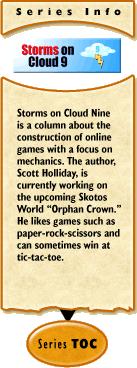 Storms on Cloud 9 #21:
Storms on Cloud 9 #21:
Choice or Lack Thereof
by Scott Holliday
2003-10-17
Like so many of my columns, this one is inspired by the latest game that I've been playing. Of course, usually my columns end up as rants, which is entirely not the point this time. I downloaded a nifty little shareware game, got a taste of it, then felt compelled to pay to see the rest. Over the next 50 hours or so of game-play, I had a really fun time.
In short, the plot was fairly simple. You have to save the universe against an insane cyborg space-fleet. In the process, you get to explore the galaxy, mine asteroids, and shoot lots of bad guys. Ok, simple enough - and fun single-player.
So why not multi-player? I've mentioned the "Save the World" mentality before in Storms on Cloud 9 #13. This time, I instead want to concentrate on all those options - and the ramifications in multi-player.
Looking around at other MMORPGs, they all seem to come with a list of stuff you can do. Chop/dig/mine natural resources, craft equipment, build houses, exterminate bunnies, etc... This is all well and good. Different players will latch onto their favorites and have fun. Or not. The question you should be asking yourself (as a designer) is whether these are choices or requirements. And whichever, is this really what you wanted?
For instance, in this little shareware game I've been playing, it's described by all the things you can do. But in reality, these are all things that you WILL do. You don't have a choice. In order to repair/refit, you have to mine resources. To find resources you have to explore. And to protect your new mining grounds, you have to fend off the evil cyborgs. This is a good design for the single-player game. It forces you to follow a simple plot and see all the neat things that they programmed for you. The game is not the choices made, but how you make them.
The question then is whether this is good design for a multi-player game. My first reaction is probably like yours: "over my dead body!" However, if you've played different games you've probably seen the result from the opposite extreme - Super-specialized, very bored players. Player A can kill monsters, but never sees the rest of the content. Player B can chop trees better than anyone, but never gets to kill monsters. Player C chooses to do neither - and finds themselves totally incapable of either.
Similarly, unless each interest is equally exciting (and rewarding), players will gravitate towards whatever best fits what they are looking for. If all the players are off exploring dungeons, why did you waste your time programming the peaceful forests? Likewise, if everyone is chopping wood in the forest, what are the dungeons for?
Some games take the high road to success by dropping all extraneous content. If it's a game about space battles, then there is nothing but space battles. Other games "enhance" the "secondary" skills by making them the only way to get ahead in the world (perhaps there is little or no loot from killing bad guys). However, the most common approach seems to be putting in a hodge-podge of otherwise useless skills and content--just so you can advertise that you have it.
What's the answer? I would say it depends on what you are aiming for. If you've got a focused game, you should carefully consider just how focused you want it to be. If you want to encourage players to explore all of their abilities, you should consider whether or not you are adding enjoyment to the game (or taking it away). And if you're doing it just so you can say you have trade skills--ask yourself if emulating your competition is really the path to success.
[ <— #20: Literally, Your Two Cents | #22: A Case for Complexity? —> ]

